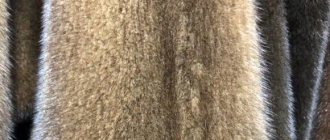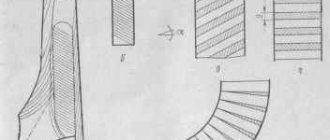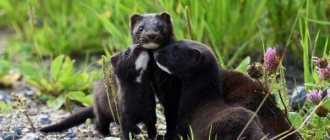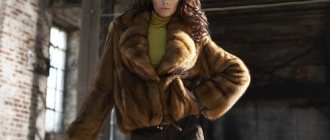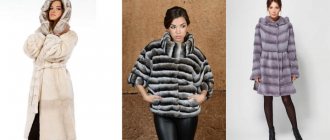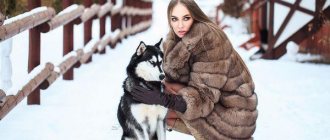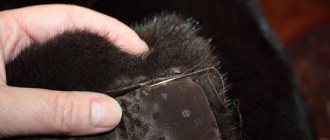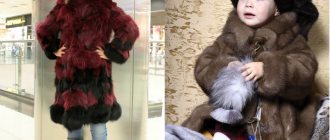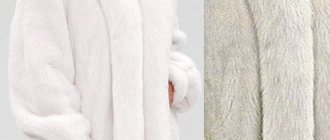Animal skins have been used by people since ancient times. To obtain them, a person had to risk his own life. Today the situation has changed, but to purchase this item of clothing you will have to save a considerable amount of money. Taking into account the high cost of a fur product, you need to know which fur coat is the warmest and which fur is generally the most practical.
Last squeak
Fur . The most popular fur is mink. A cheaper alternative is ferret and muskrat. Nutria is economical.
As for elite furs, this is undoubtedly sable. Other prestigious furs include lynx, marten and chinchilla. And finally, the rabbit (chinchilla coat) is again in demand, as well as the beaver, goat and even the mole.
Style . As for the style, “wild skins” are in fashion. All edges (hem, sleeves, sides) are left as if torn. In the same format - mink without lining with carelessly processed cuts. Squeak of the season!
Coloring . As for color, fur coats of the most incredible colors have now come into use, including bright blue, soft pink or pale lilac. For fashionistas - mink in complex complex tones, such as gray-green or brown-beige.
Sewing . Another trend that has not lost ground for several seasons is combined fur products. Designers are experimenting with different textured furs of variegated natural colors - chipmunk, hamster, squirrel of all kinds. In this case, the mink can be combined with the African fox, and the lynx with the sable. Moreover, fur is also combined with fabrics - velor, satin and suede. A knitted fur coat is still an object of temptation for many women. This technology, created by Canadian designer Paola Lishman, is essentially a method of weaving using a special elastic base mesh. Initially, beaver skins were used for this, but now fur knitwear is also made from mink and other expensive furs and is present in the collections of the best companies in the world.
Let's choose who is warmer?
- Mink and mouton. A mink coat has become an indicator of the status of its owner. It looks rich and is very expensive. But the thermal properties of a mouton are significantly higher than that of a mink. Mouton is a specially treated sheepskin. A product made from it has the ability to maintain optimal temperature. Previously, the mouton was not held in high esteem due to its unattractive appearance. Nowadays, mouton fur coats look no worse than mink ones, thanks to painting and special processing. Modern technologies make it possible to produce models from mouton of different textures, shades and styles. Mouton is characterized by durability, high thermal characteristics, resistance to dampness and easy care.
- Mink and beaver. The fur of both animals is beautiful, durable and practical. But the beaver undoubtedly wins in terms of heat retention.
- Fox. Fox coats are rightfully considered the warmest due to their long, thick hair. Plus, they are bright. And models made from silver fox, whose black and silver fur is soft and beautiful, are classified as elite outerwear.
[ads5]
Haircut and fur in a hole
The most common types of fur processing, other than dyeing, are plucking and shearing.
Plucked fur is obtained when, using a special device, long and stiffer hairs are pulled out of the fur, leaving the velvety undercoat untouched. This makes the fur coat very “plush”.
The haircut removes only the top long hair. Fur haircuts are done in different ways: with a fabric texture, with mohair. Most often, a combination of plucking + shearing technologies is used: after cutting the pile into “velvet,” it is trimmed to the desired height, or “corduroy” is made from “velvet.”
Recently, “high” fur processing technologies have become widespread - laser cutting and through perforation.
Through perforation is less common. The product is based on mink or the now fashionable swakara (South African astrakhan fur), and with the help of a laser, a small pattern is applied to it, which makes the fur look like elegant lace.
Distinctive features of fur
Fur outerwear, sparkling with a beautiful shine, is made from a variety of natural raw materials. Natural fur, which has an attractive appearance, is a traditional carrier of the idea of chic and beauty. Scandinavian skin is distinguished by a shiny pile of the same length with a rather thick down, which quickly restores its original state after lightly stroking in any direction. The quality of natural fur can be easily determined by the light cream appearance of the inner surface of the natural down. Natural fur practically does not allow moisture to pass through, withstands wet snow and a humid atmosphere well, and therefore retains its attractiveness and natural beauty for several autumn-winter seasons. Fur items in cold or warm tones have a diverse color spectrum.
Advanced fur colors
Today's fashionistas are not satisfied with the colors of fur in which nature dyed it, and therefore designers all over the world compete to come up with new color solutions. In addition to regular tinting, there are many multi-layer dyes.
One of the new trends is pile dyeing in combination with bleaching. In this case, coloristic effects are obtained, the essence of which is the different color of the hair at the base and at the tip. For the “Snow-top” effect, a dye is used to produce white tips on darker fur. The “Brisa” effect is obtained with two-color dyeing, when the base of the fur is dyed, for example, beige, and the ends of the hair are brown. Such effects are usually achieved using long-haired types of raw materials - arctic fox, white rabbit, llama. By bleaching the mink, you get the “Gold” effect (gilding of fur). This is how furriers imitate golden sable.
Bleaching followed by dyeing allows you to obtain various bright fancy colors of mink, nutria, black and colored astrakhan fur.
Another option. Mink, rabbit and some other furs are stenciled (superficially) painted to look like “leopard”, “tiger”, etc.
Warm and durable fur coat
Of course, the original purpose of a fur coat is to warm its owner.
The warmest fur is that of the fox, as well as mouton (high-quality sheepskin). Then, according to the level of heat conservation, come sable, arctic fox, fur seal, beaver, chinchilla, nutria, mink, astrakhan fur. And the coldest furs are marmot and ermine. Fur coats made from the skins of males are warmer, but females are colder. If the winter in your area is quite harsh, that is, frosty and windy, give preference to fluffy furs, such as arctic fox, fox, raccoon dog, and wolf. If you live in a humid climate, then you need a “waterproof” fur coat made from nutria, beaver or otter.
Also, when choosing fur, it is extremely important to formulate for yourself how long you plan to wear it. The fur of the river otter and sea beaver is taken as the standard for durability (100% strength). They are the most durable and can withstand more than 20 winter seasons (1 season = 4 months). Although a lot depends on the quality of the fur, its processing and how the fur is cared for.
Below is the comparative wear resistance of various types of fur in points.
Wear resistance comparison table
| Type of skins | Wear resistance (in points) |
| Otter | 100 |
| Otter plucked | 95 |
| Brown and black bear | 95 |
| Natural river beaver | 90 |
| Plucked river beaver | 85 |
| Natural sable | 80 |
| Natural cat | 80 |
| Natural seal | 80 |
| Painted seal | 75 |
| Leopard | 75 |
| Natural raccoon | 75 |
| Painted cat | 70 |
| Mink | 70 |
| Natural skunk | 70 |
| Dyed sable | 65 |
| Astrakhan | 65 |
| Marten | 65 |
| Painted raccoon | 60 |
| Natural wolf | 50 |
| Painted soft marten | 45 |
| Mountain marten | 45 |
| Natural muskrat | 45 |
| Fox red and silver-black | 40 |
| Australian opossum | 40 |
| American opossum | 37 |
| Painted mountain marten | 35 |
| Muskrat painted to look like a seal | 35 |
| Fox painted black | 25 |
| Natural squirrel | 25 |
| Nutria plucked | 25 |
| Ermine | 25 |
| Natural lynx | 25 |
| Columns | 25 |
| Possum painted | 20 |
| Painted squirrel | 20 |
| Lynx painted | 20 |
| Arctic fox blue | 20 |
| Broadtail | 15 |
| Chinchilla | 15 |
| Mole | 7 |
| Rabbit | 5 |
| Hare | 5 |
How to choose a fur coat that will last for many years?
There are signs of the quality of a fur product that you need to pay attention to when purchasing.
- Kind of animal. When purchasing an inexpensive rabbit or hare fur coat, be prepared that it will last no more than 3 seasons if treated well. It will quickly lose its original appearance. For this reason, hats, fur coats, and vests for children are made from the skins of rabbits, squirrels, and hare. Children grow quickly; they do not need the product to remain durable for several years. But at the same time, such things have good thermal qualities and low cost.
- Treatment. The fur of a quality fur coat is thick, without bald spots, shiny, and elastic. The mezdra is white. It should not rattle when shaken. It is worth paying attention to how the lining is sewn. If it is not sewn tightly, this indicates that the manufacturer is confident about the quality of the product and gives the buyer the opportunity to evaluate the finishing of the skin from the inside.
- Sewing. Fur coats sewn “unfolded” and whole are allowed. It all depends on what kind of fur the product is made of. If the animal has thick flesh (beaver, raccoon, nutria), then it is usually sewn “unfolded”. In this case, the fur coat will fit better and will not look like a sheath. And if the fur is thin (mink), then a fur coat sewn “in loose” can make plump ladies look slimmer. In any case, tailoring depends on the style, length and even color of the product. Pay attention to the quality of the seams. The fewer there are, the stronger the product.
- Fur dyeing. Fur dyeing can be done for different purposes. Often the manufacturer uses it to hide defects. For this, dark shades are usually used. But there is fur that needs to be dyed, since in its original form it does not look very attractive. For example, nutria. Fur is now dyed and tinted using high-tech dyes that do not affect the quality of the product. Therefore, if you really want to buy a fur coat made of purple fox fur, then you should not be afraid. To check whether colored fur will not get dirty when worn, you need to wrap a few hairs in a handkerchief and rub it a little. If there are no traces of paint on the scarf, then you don’t have to worry about the quality of the dyeing.
- Dressing. To check the quality of the workmanship, you need to crumple any part of the fur product. It should immediately return to its original shape. To check the quality of the fur, stroke it against the grain. The down should be clearly visible, thick, and the hair should be elastic. The fur should not separate from the skin, leaving hair in the hand.
[ads7]
Some clever manufacturers manage to replace expensive fur with cheaper ones. So, instead of sable they can sell marten, instead of nutria - beaver and even rabbit - instead of mink. Mink and rabbit fur differ in stiffness. A rabbit's spine is much softer than a mink's. [ads2] When choosing a fur coat, you need to proceed from the possibilities of your own income and the purpose of the purchase. If you need it in order to emphasize your solidity, then you can purchase a lightweight model made of mink or arctic fox. But if you plan to spend a lot of time in the cold, then you should think about purchasing a fur coat made of mouton, fox, or wolf. When buying an inexpensive fur coat made from a rabbit, gopher or hare, you need to be prepared for the fact that it will not last long. But this option is suitable for those who like to regularly change their wardrobe. If you do not have the opportunity to often buy such expensive things, perhaps you should think about purchasing a more expensive but high-quality model. Therefore, before making such an expensive purchase, you need to carefully weigh everything, think it over and choose the appropriate option in terms of means and application.
2 comments on “Which fur coat is the warmest and most practical?”
- Svetlana:
11/25/2020 at 11:52 am
I assumed that a mouton could be one of the warmest furs, my grandmother had a fur coat made of a mouton, the color “leopard” - it looked amazing. She always said that she was always warm. But about the fox, I didn’t think it was so warm. I like mink fur, although it has average thermal characteristics, but it lasts a long time and retains its appearance. Of course, I would like a sable fur coat, but the prices...
Answer
- Natalia:
01/30/2021 at 16:20
I myself really like the arctic fox fur coat, it’s warm and has shown itself to be excellent when worn. When my husband and I bought it, I chose it simply because I liked it - the color, the shape, the quality of the fur (my grandfather was a furrier and I understand a little about this). I heard that animal fur retains heat in different ways, but I never paid attention to it. Now many people buy a fur coat just to show that they can afford it.
Answer
Does easy mean good?
It is generally accepted that a high-quality fur coat must be light. It is not always so. For example, astrakhan fur, nutria and polished tsigei are always heavy. In addition, when choosing a fur coat, remember that its lightness can be deceiving. In pursuit of savings and weight reduction, furriers often stretch the fur greatly, resulting in something like a stretch effect. In this case, only the skin stretches, the number of hairs on it does not increase. As a result, it becomes thin and therefore more fragile.
The weight of the finished product depends on the length of the fur, the quality of the skins and the presence of insulation. For example, modern batting may be no thicker than an Orenburg scarf. The latest methods of fur processing make it possible to sew even double-sided fur coats - fur on the outside and inside. Or fur on the outside, and leather on the inside, with painting, for example, like a leopard.
Based on weight, fur is divided into heavy (wolf, raccoon dog, otter, beaver, arctic fox, sable, astrakhan fur), medium-heavy (mink, rabbit, nutria, muskrat, squirrel, ferret) and very light (hamster, gopher, hare). The weight of the product also depends on the dressing of the skin: the better the dressing, the lighter the fur coat.
How to care for fur
Due to its wear resistance and versatility, this material is quite easy to care for. Why it is valued by owners of nutria products.
However, with proper care, the service life of these products can be extended to 10-12 years. Moreover, all this time things will look beautiful and aesthetically pleasing.
Care methods:
- Combing. Since the fur has a fluffy undercoat, the fallen hairs may not be removed, but remain in the structure, forming tufts and tangles. This spoils the appearance of the product. Therefore, the fur must be brushed regularly with a stiff brush.
- If the fur becomes dirty, you can wash it with shampoo foam and then wipe it several times with a wet cloth. Wet salt is also good for removing heavy stains.
- If your fur coat gets wet outside, you need to shake it well several times to remove excess moisture and then let it air dry.
- In summer, fur coats should be ventilated and hung in clean air. It is important that the fur is not exposed to sunlight.
- To prevent moths from getting into your fur, it is enough to use bags with aromatic herbs: lavender, mint, sage.
Thanks to these simple techniques, the product will remain beautiful and stylish for a long time.
Sewing methods
There are several basic methods for sewing fur coats.
The "dissolution" method . Each skin is cut into diagonal strips ranging from 0.4 cm to 6 cm wide (in some cases more), which are sewn together to form a long and narrow skin. This is done so that the seams are not visible on the fur side along the entire length of the product. In recent years, the “unraveling” method has also been used in sewing products from the skins of almost all animals. With this tailoring, the so-called flying silhouette is obtained; the fur product has no visible joints between the skins and looks “monolithic”. The disadvantages of this technology include some weighting of the product and a huge number of seams that hide the quality of the original skin.
The "stitching" method . This is how fur coats are mainly made from fluffy fur (fox, raccoon, arctic fox, etc.). Between the strips of fur, cut as for “dissolution”, strips of suede or leather are sewn. In this case, the long fluffy pile covers the strips of skin, so that they become invisible. This is done, firstly, to save valuable fur, and secondly, so that the fur coat becomes lighter in weight. As with sewing “unraveled,” these fur coats have a lot of seams that can unravel over time.
The “skin to skin” method is used when sewing from whole skins.
The "pieces" method . The fur coat is sewn from small pieces stitched “on the bias”, but they are adjusted one to one on the computer so that the seams are not visible from the outside. The fur flows like a waterfall and even shines more than usual. Due to the expensive technology, such fur coats cost the same as whole ones. But as you wear it, the edges between the pieces become more and more noticeable; with each movement, the fur coat seems to “unfold” into many parts.
However, designers continue to experiment with fur, adding new technologies to the furrier business.
The most practical fur coats
- Products that have adjustable cuffs, a wide silhouette, and a three-quarter length are worn the longest. Welted loops with fur trim and a zipper, on the contrary, will very quickly put your coat out of order.
- To avoid the temptation to put a mobile phone, a bunch of keys and a loaf of bread in your pocket at the same time, it is more practical to have only an internal pocket on your fur coat.
- The best material for a fur coat belt is fur, since suede and leather belts quickly damage the pile.
What to pay attention to
- Ask the seller for a certificate of conformity.
For several years in Russia there has been a requirement for mandatory certification of all types of fur products. In accordance with it, any fur products, whether domestic or foreign (and sold anywhere!) must have such a document. It certifies that the product has passed appropriate tests. There is no document or the seller mumbles something in response - draw your own conclusions. In a store, unlike a market, they are almost always ready to present a certificate for each fur coat. It contains information about both the manufacturer and the organization that issued the certificate. If you wish, you can even call them and check information about the product. - Pay attention to the markings. If a product lays claim to the high title of a branded item, then the lining must have uniform labels, not in one, but in several places. There must also be a branded tag that informs the buyer about how to care for the fur coat.
- Check the fur for “stability”: stroking the pile from top to bottom and bottom to top, pay attention to how elastic and resilient it is. The pile should quickly return to its original shape, without crumbling or breaking. It should feel both silky under your palm and not leave a “greasy” feeling. High quality fur is shiny and does not look stuck together in icicles. Over the entire surface of the product, the pile should be even in length and equally thick (this also applies to the undercoat). Feel free to tug the fur in different places of the product - the hairs should hold firmly. If the fur is propped up, they come off easily. It's not worth taking such a fur coat.
- Run a damp handkerchief over the pile if you have chosen a dyed product. If marks remain on the scarf, the fur coat is in the process of progressive baldness.
- It is also useful to... smell the fur on the chosen fur coat. Handcrafted fur emits a sharp, unpleasant odor. It's better to stay away from this outfit.
- Look under the lining.
On long fur items it is usually not attached at the bottom. This, by the way, is a good indicator: it means the manufacturer has nothing to hide. However, if it is sewn on, ask to tear off the edge. Carefully inspect all seams and joints of the skins. They should be stitched, not glued (make sure there are threads present). Even if the skins are sewn together, check the quality of the seams. To do this, spread the fur and, using your fingers, examine how well and neatly it is made, whether the threads are sticking out, etc. Are the seams sewn thinly, neatly and almost invisible? This means the item is of high quality. - Pay attention to the dressing of the mezdra (the reverse side of the dressed hide). To ensure its quality, remember the fur well with your fingers. If you feel that the flesh is hard (creaks, crunches, etc.), this means that the technological process was disrupted during processing of the skins. Properly prepared flesh should be soft and tender to the touch. Part the undercoat and make sure there are no cracks in the undercoat layer? Are there any traces of moths?
Why so expensive?
The price of a beautiful fur coat largely depends on the prestige of the fur (for example, the cost of a sable coat reaches up to 200 thousand dollars) and on the size of the skin plates. The size of a whole skin is at least 15x15 cm. If the “cut” area is smaller - this is a “half-plate”, the cost of such a fur coat should be 20-30% cheaper. Although a fur coat made from pieces will serve you for 2-3 years before falling apart, it costs much less. At a relatively low price, you can also purchase a jacket made from the tails or foreheads of an animal. The cost is influenced by the thickness of the hair of the skins, as well as its height, softness and shine.
| Do you know what the difference is between fur and fur raw materials? Fur raw materials are the skins of wild animals, even if they are raised on a fur farm: sable, marten, lynx, coyote, seal, beaver, muskrat, wild mink, wild fox, etc. Fur raw materials - fur of domestic (farm) animals: mink, arctic fox, chinchilla, astrakhan fur, nutria, rabbit, mouton. Keep in mind that among wild animals the most valuable type of fur is winter, but among domestic animals it is the spring fur that is most valuable. |
The length of the product also plays an important role - the longer the fur coat, the more expensive it is. In addition, the manufacturer can increase the price by a third for a super fashionable style or a special fur color.
The cheapest mink is light brown, then, as the price increases, there are dark brown and a variety of red ones - from juicy golden honey to light amber. Even more expensive are black mink, beige, gray and blue.
In the next price category are the so-called “tourmaline” (beige undercoat and brown long hair, which creates an interesting smoky effect) and white fur (sometimes with gray hair). But the most expensive one today is the “black diamond” mink, black with a blue or purple tint.
The sale of fur coats begins in January-February, during the holidays. But such promotions are also held in the summer, then you can buy a fur coat at half the price than in winter. But it’s much easier to choose the best one during the season when new goods arrive. If you have high requirements for your upcoming purchase or you wear “critical” sizes (42, 56), then you should not hope for a sale. In some fur salons you can buy a fur coat on credit.
General Tips
The choice of a fur coat depends, first of all, on the woman’s preferences. Criteria such as body type, lifestyle, current fashion trends, and taking into account the opinions of experts play a big role in this important matter. As for the latter, they recommend paying attention to the following points:
Color
Recommendations from colorists designed for different types of women will help you choose the tone of the product:
- “Lady-autumn” and “girl-spring” are in harmony with warm tones: pinkish, orange, pistachio, beige;
- “Winter woman” and “Summer lady” look organic in fur coats in cool shades: gray, greenish, blue, chocolate, metallic.
- classic colors - white and black - suit almost everyone.
Don't forget about the modeling function of color. A plump woman will look slimmer in a dark brown or black fur coat. And for skinny girls it is better to prefer lighter outerwear.
Size
The most important guideline when choosing a fur coat is its compliance with the body parameters. The main thing is that the product is not tight. Classic models have a loose fit. A fur coat that fits a voluminous figure is obviously a wrong decision. This outfit loses its most important “plus” - elegance.
A product that fits will provide one hundred percent comfort. You don’t want to pull him back or move him forward, pull back the collar squeezing your neck or roll up his long sleeves, like Pierrot’s. Once you try on such a fur coat, it will be difficult to part with it.
Style
A stylish cut of a fur product, taking into account the specific proportions of the body, height and build - isn’t this the dream of every customer? For it to come true, you need to keep in mind the following nuances:
- a woman with a miniature build will simply “drown” in a long flared fur coat;
- Elements such as a peplum hem and a massive collar will help to correct an orange-type silhouette - without any signs of a waist;
- a fur coat to mid-thigh, widened towards the bottom, with an emphasis on the waistline, will emphasize the advantages of a slender figure;
- those with a full bust and wide hips should look for cropped trapezoidal outerwear;
- Tall and thin ladies will wear fluffy sable or arctic fox fur, as well as mink crosspieces - fur coats sewn from skins located not lengthwise, but across.
Knowing these little secrets will greatly benefit women who want to harmonize their silhouette and keep up with fashion.
Heat preservation
Bear or reindeer fur provides the best warmth, but products made from these materials are not common in our country. The skins of sable, arctic fox, raccoon dog, and beaver are considered very warm. They are distinguished by the largest amount of guard hair and the thickest down. True, they are all quite heavy.
Less heat-resistant are astrakhan fur, mink, ermine, and chinchilla. Products made from goat, rabbit, or marmot leave little hope of not freezing in severe frost. And the fur of gophers and hamsters provides virtually no warmth.
Purpose
Fashion trends of recent years dictate the choice of fur products taking into account the purpose of purchase. In this regard, fur coats can be divided into two categories:
- for every day, including for work - light, practical mink, astrakhan, hare fur coats in tandem with jeans or trousers;
- for special occasions - products made from fox, lynx or sable fur in combination with an elegant dress or a spectacular suit.
Life time
To find out how many seasons a new fur coat will last, you need to take into account the following gradation (the numbers in it indicate the number of seasons that the skins of the listed animals can withstand):
- 20 – river beaver and otter;
- 10 – mink;
- 7 – marten, blue fox, astrakhan fur;
- 5 – fox, nutria;
- 4 – squirrel;
- 2 – hare, rabbit.
Delicate handling
Even a fur coat that is good in all respects requires the same good attitude. If you wish her a long life, give up the habit of carrying a bag on your shoulder. Otherwise, the fur will dry out and become bald... If your coat gets wet while wearing it, let it dry naturally in a cool, dry place. Do not use artificial heat (no hair dryers or irons!). Brushes and combs are also inappropriate. To restore the softness and fluffiness of the fur, shake the coat thoroughly when the fur is dry. Fur coats should be cleaned in special dry cleaners.
By lenght
When choosing the length of a fur coat, you should definitely take into account two factors: how this fur coat will be worn (public transport, car, going to special events) and the girl’s figure:
- Long, floor-length fur coats amaze with their luxury. But they are completely unsuited to the city crowd and travel on the subway and bus. They look great on tall and slender women; for shorter girls, it makes sense to accentuate the waist with a belt and wear high-heeled boots.
- Medium length (mid-thigh) is the most comfortable and versatile. Classic boots and an elegant bag will help create an elegant and complete look.
- Short fur coats look great on miniature Thumbelina, and are not contraindicated for slender girls of model height. If weather conditions permit, they are very comfortable to wear.
- And finally, the famous “car lady” style is a very short sheepskin coat, often with ¾ sleeves, which is comfortable while driving a car.
